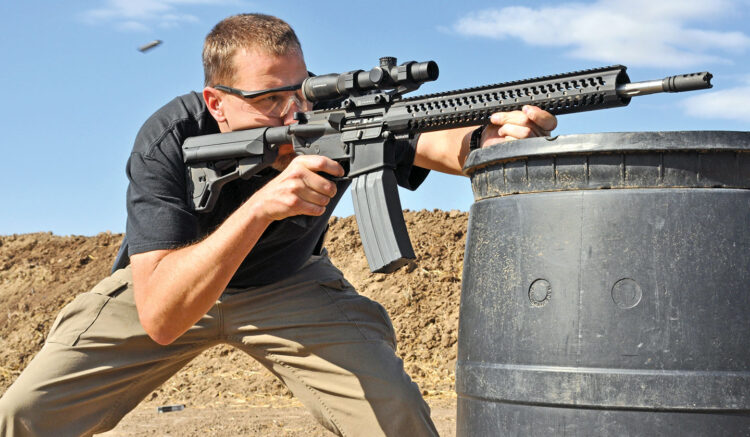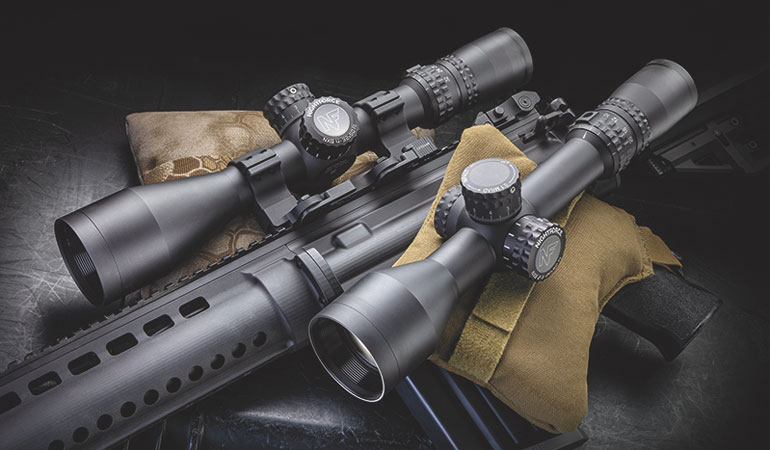 When one starts shooting there is a usually a certain logistical flow to purchasing. First there is the platform. Pistol or rifle based on your interest, level of novice or proficiency, and application. For those purchasing a rifle, there are sport, competition, self defense, hunting and tactical applications. For most all of these, the next usual, logical purchase is an optic. There are many options, for many budgets, different applications and of course, looks.
When one starts shooting there is a usually a certain logistical flow to purchasing. First there is the platform. Pistol or rifle based on your interest, level of novice or proficiency, and application. For those purchasing a rifle, there are sport, competition, self defense, hunting and tactical applications. For most all of these, the next usual, logical purchase is an optic. There are many options, for many budgets, different applications and of course, looks.
Most people want to make their shooting experience accurate and simple. So, matching a suitable scope to assist their rifle to improve results is important. If you decide to get a scope for your rifle, and eventually you probably will, the various available options can boggle the mind. There is a wide range of rifle scopes available in the market; the inexpensive, or expensive, options for high and low magnification settings, and more. Likewise, there are different reticle options available. The two different reticle placement options first focal plane (FFP) and second focal plane (SFP) optics. The difference between the two is the placement of the reticle, as relates to the scopes magnification.
A reticle does many things, such as accounting for the range, as relates to bullet drop, likewise, it helps to provide hold over for windage. There are many types of reticles, but for this blog we are really looking at FFP (First Focal Point) Vs SFP (Second Focal Point) differences.
The Focal Point is the point on a glass tube on which the reticle sits. With a first focal plane scope, the reticle’s size is variable, which means that the size of the reticle changes with the change in magnification of the scope. Smaller at close range and larger at long range. If you have a scope with variable magnification, with the reticle in the first focal plane and you increase your magnification from 1X to 12X, the reticle’s size will increase. The increase in magnification of the lens increases the size of everything in front of it. As the reticle, in this case, is mounted in front of the magnification lens; thus its size also increases. In the second focal plane, the reticle is mounted behind the magnification lens, and the change in magnification does not change the reticle size. At any power setting, the reticle size will remain the same.
With a first focal plane scopes the reticle remains in proportion with the target in view at all magnifications. This allows you to easily adjust the trajectory over long ranges. The hash marks of the reticle remain accurate, enabling speedy target acquisition and more accuracy. You can accurately mark the reticle on the target at all ranges without making any adjustments to your scope. It also works well with the scopes having BDC reticles. If you want to determine your scope’s range and bullet drop, it is easy to measure it with a first focal plane. The downside of using an FFP scope is that the reticle becomes very small when used in low magnification settings. It becomes hard to see and use. It becomes even harder to see at close range when the light is low, it becomes even harder to view.
Second focal plane scopes allow the reticle to remain to remain static at the target at all magnification settings. They are typically easier to manufacture and are more commonly available for an affordable price. Since the reticle has the same size at all magnifications. the sub tensions of the reticle do not work accurately at every range. This is especially true at longer ranges.
People who plan to shoot for distance and accuracy will probably prefer an FFP scope as they need to take quick shots and use holdover. Also, those who use high-powered scopes need to consider an FFP rather than an SFP.
If one wants to use lower-power, variable optics, the SFP will probably work better for you. At low magnification, the reticle is bigger and hence faster. Shooters prefer an SFP scope for close-quarter shooting. Second focal plane scopes are usually good for most hunting, as hunting ranges are typically 300 yards or less.
Whether you want the close range a second focal plane scope offers or want to reach out and bang steel at further distances with a first focal plane scope. now you know the difference between the two. We carry a full selection of scopes here at Shark Coast Tactical. We love the Night Force scopes. You really can’t buy a higher quality scope. https://www.sharkcoasttactical.com/product-category/accessories/optics/
Shark out!







